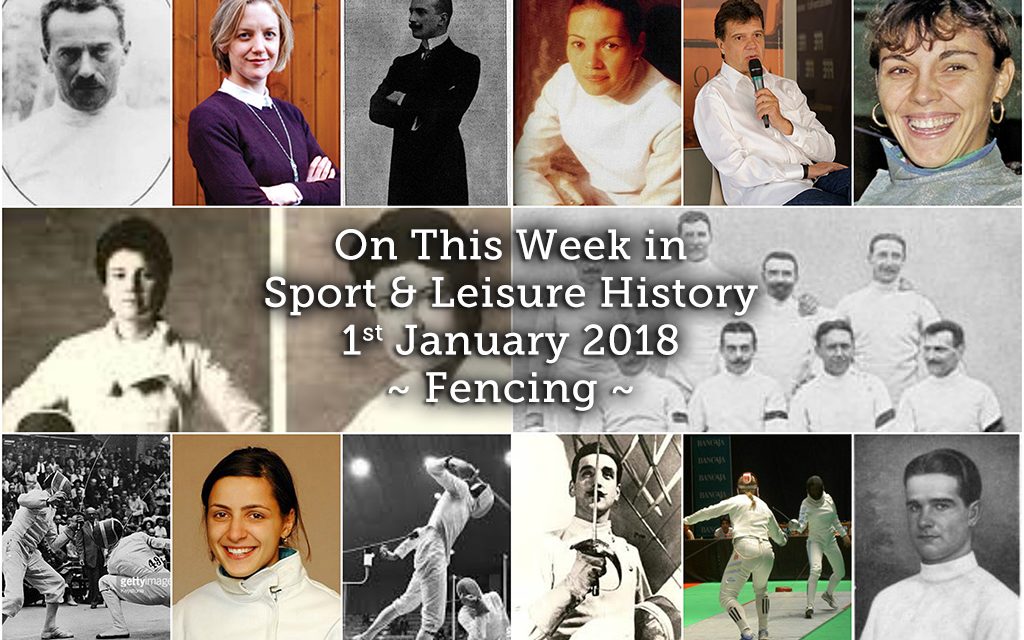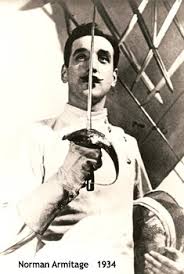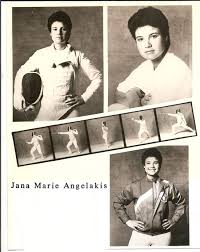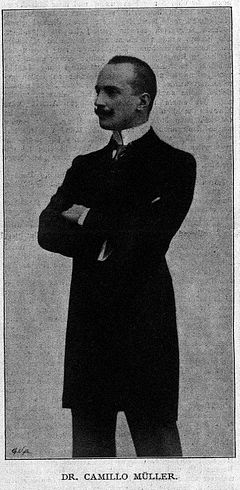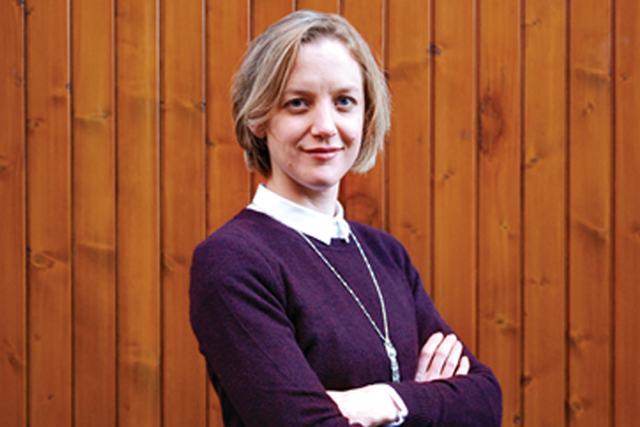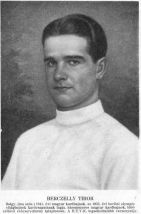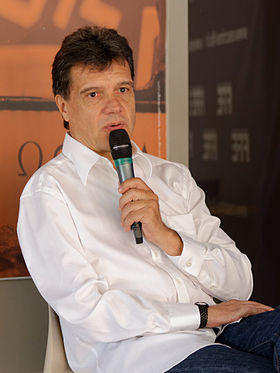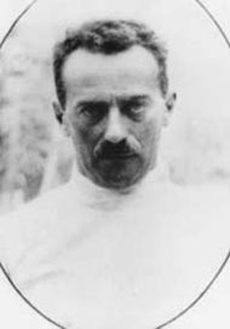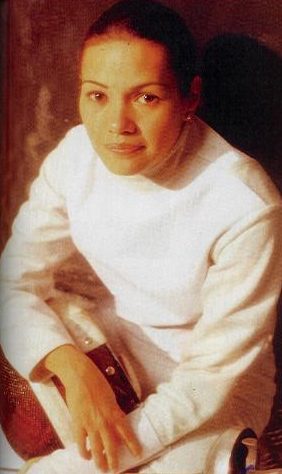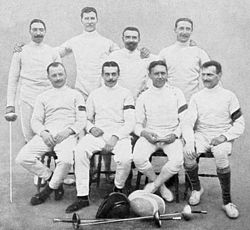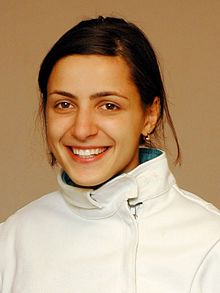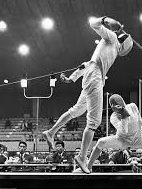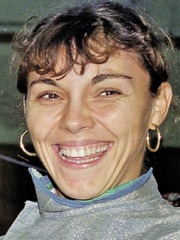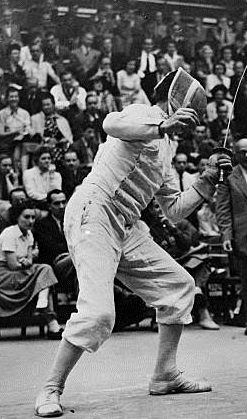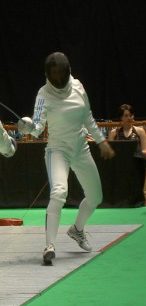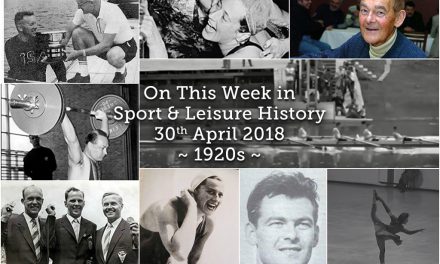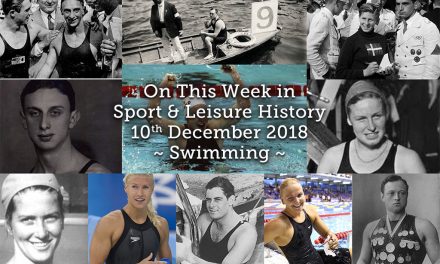Happy New Year, with good wishes to all Playing Pasts authors and readers for a successful 2018
1st Born on this day in 1907 in Albany, New York, American fencer Norman Cudworth Cohn-Armitage. He took up fencing while a student at Columbia and in 1928 won the IFA sabre individual championships and with it a place on the Olympic team. He competed in six Olympic Games in all, and his span of 28 years between appearances is unmatched among US Olympic athletes. At the 1948 Games, Armitage was the cornerstone of the sabre team that won the bronze medal. Also in 1948 he was part of the three-man colour guard that carried the American flag in the opening ceremony. At the 1952 and 1956 Olympics, Armitage was standard bearer himself. His record domestically is as lengthy as his Olympic record. In 25 years he finished in the first three in the individual sabre 22 times, winning on 10 occasions. He also won seven outdoor sabre titles and was a member of six national championship teams. Armitage spent his business career first as a chemical engineer, then briefly as a patent lawyer before returning to chemical research. In a chemical accident in January 1936, he was the victim of third-degree burns on his right hand and arm. He was not expected to be able to fence again, but through exercise and determination he strengthened the arm sufficiently to make the 1936 Olympic team. He died on 14th March 1972 in New York.
Félix Galimi, from Argentina, was born in 1921. He competed at the 1948, 1952 and 1964 Olympics. He won the 1951 Pan American Games foil, as well as the 1955 Pan American Games epee and foil team events. Other notable podium finishes included: – 2nd in the 1951 Pan American Games team foil and 3rd in the 1955 Pan American Games sabre team. His best Olympic performance came at the 1948 and 1952 Games where he came 5th both times in the team foil. He died the day after his 84th birthday in 2005. His brother Fulvio, six years his junior, was also an Olympic fencer, who competed in 1948 and 1952. He earned a silver medal in the individual foil event at the 1951 Pan American Games and three medals at the 1955 edition: gold in team foil and bronze in individual foil and team sabre.
Hungarian fencer Ferenc Czvikovszki was born today in 1932. He competed in the team foil event at the 1960 Summer Olympics. If you take 1904 out of the equation as neither country sent teams to the St. Louis Olympics then every Olympic team foil competition had been won by either Italy or France. Indeed, only once, back in 1924, had the two nations failed to finish 1-2 in the standings. Their dominance faded in the late fifties with the emergence of the Soviet Union onto the world stage. The Soviet team had won the world title for the first time in 1958 and arrived in Rome with a young team whose average age was just 24. For the first time in decades the medals were decided by gold and bronze medal matches rather than a final pool so the title would be decided in a straight match-up between the USSR and Italy. Although Italy, on average a decade older per man, had the advantage of greater experience, they failed to be a match for the Soviets and fell by a score of 9-4. Germany, who had earlier eliminated France, defeated Czvikovszki and his Hungarian team for third place.
American Jana Angelakis, from Peabody, Massachusetts where she competed for the Tanner City Fencer’s Club, was born in 1962. She went to college at Penn State University, where she was an AIAW Champion in 1981 and NCAA Champion in 1983 and helped Penn State win the team foil title in 1983. Angelakis was US Foil Champion in 1979 and 1981-82, and was runner-up in 1983-84. She competed at the 1981 and 1982 World Championships and the 1979, 1981, and 1983 Universiade. She qualified for the 1980 US Olympic team but did not compete due to the American boycott of the 1980 Moscow Olympics. She was one of 461 athletes to receive a Congressional Gold Medal instead. At the 1984 Games she took part in the individual and team foil events, where she placed 28th individually and 6th as part of the team.
- Norman Cudworth Cohn-Armitage.
- Jana Angelakis
2nd – Austrian sabre fencer Camillo Müller was born on this day in 1870. He competed in the 1900 Olympics in which he reached the finals and finished in eighth place overall.
Born today in 1896, Polish fencer, athlete and Major of the Polish Army – Władysław Dobrowolski. In his youth he was active in the Polish independence movement and fought in the Polish-Russian war (1919-21). In 1924 he graduated from an officer’s course in physical education and participated in the 1924 Paris Olympics as a track and field athlete in the 100m, but was eliminated in the heats. He won 11 Polish Championships in various track and field events. It was not until the age of 35 that he began taking fencing seriously. He won bronze in the team sabre at the 1932 Olympics and at the unofficial World Championships in 1934, Dobrowolski won a team bronze medal. In September 1939 he took part in the Polish Defence against the Germans. As an officer, he was a sports instructor and manager after the war. In 1957, he became the first president of the Polish Luge Federation and was the author of many sports books. He was the father of Jerzy Dobrowolski, a satirist, playwright, actor and director. He died aged 73 in 1969.
Gerda Munck, who was born today in 1901 in Kolding, Denamrk and represented the Fiftteklub Cirklen club. She participated in the 1932 Games in Los Angeles in the individual foil, finishing in 7th place. She was also part of the Danish fencing team who competed at the 1932 World Championships in Copenhagen.
Russian Nailya Gilyazova, born in 1953, won gold in the women’s team foil event at the 1976 Olympics and a silver in the same event at the 1980 Games.
Sergey Koryashkin from Russia was born in 1960. He won a silver medal in the team sabre at the 1988 Olympics
Thomas Gerull, German épée fencer was born in 1962. He won a team silver at the 1988 Olympics.
British fencer Eloise Smith was born on this day in 1978. She competed in the individual foil at the 2000 Olympics. She attended Haberdashers’ Aske’s School for Girls in Elstree, before studying English Literature and Language at St Edmund Hall, Oxford, from where she graduated in 1999. She was placed 28th in the overall final standings at the 2000 Games.
- Camillo Müller
- Eloise Smith
3rd– Hungarian Tibor Berczelly was born in 1912 in Budapest and died on 15th October 1990 at the age of 78. He won three gold and two bronze medals at three Olympic Games between 1936 and 1952. In Berlin, London and Helsinki he and his Hungarian team mates were Olympic Team sabre champions, at Helsinki, his most successful Games, he also won bronze in the team foil and individual sabre.
Helga Koch, German foil fencer was born in 1942. She represented her nation in the 1968 Olympics in the team foil competition, where the German team finished in fifth place overall.
Another female German fencer Sabine Hertrampf born in 1955, competed in the individual and team foil events for East Germany at the 1980 Olympics. She was placed 23rd individually and eighth with her team.
Also born today in 1955 was France’s Michel Salesse. He had polio as a child and his right arm was shrivelled and mostly without function, thus he was forced to become left-handed. Salesse was a member of the gold medal winning French men’s epee teams at the 1980 Olympics, 1982 and 1983 World Championships. He also has an Olympic team epee medal from the 1984 Games. At the
On this day in 1962 Italian Olympian Carola Cicconetti was born. She competed in both the individual and team foil at the 1984 Olympics. Her best placing was 4th with the team at those Games.
Andrea Chaplin, born in Adelaide, Australia in 1964, competed in the individual foil at the 1984 and 1988 Olympics, being placed 32nd and 42nd respectively.
Andrea Cassarà, Italian Olympic fencer was born in 1984. Five days after capturing bronze in the individual foil, he helped his team mates to win the team gold in the 2004 Games, despite a negative personal record (13-15) in the final against China. His record includes various other success: the 2006 World Cup, team gold at the 2003 and 2008 World Championships and three individual European titles. In 2007, Cassarà reported his coach, Stefano Cerioni to the fencing federation for military style initiation rites, although the two have since reconciled. He also won gold in the team foil event at the 2012 London Olympic Games.
- Tibor Berczelly
- Michel Salesse
4th–Otto Herschmann, born on this day in 1877 in Vienna, competed in two different sports at the Olympics. His first Olympic appearance was in swimming, losing the 1896 100m freestyle competition narrowly to Hungary’s Alfred Hajos. He returned to Athens a decade later, this time as a fencer but failed to reach the final stages of the competition. At the Stockholm Games in 1912 he won silver with the Austrian sabre team. That same year, he became president of the Austrian Olympic Committee, a position he held until the end of World War I. For almost two decades (1914-1932), he served as the president of the Austrian Swimming Federation. Herschmann was in private practice as a lawyer in the 1940s. He was persecuted during the era of the Nazis because he was Jewish and was deported from Vienna on 14th January 1942 to Izbica concentration camp in German-occupied Poland. He most likely died on the 17th June 1942 in Sobibór extermination camp in Lubelskie, Poland, most likely being gassed to death.
Born in 1903, Christopher Hammersley was a British fencer who competed in the team foil event at the 1936 Berlin Olympics. He died in January 1994 aged 91 on the Isle of Wight.
German fencer Ernst Rau was born in 1927 and died on 2nd May 2012 aged 85. His participation in the 1952 Helsinki Olympics was the highlight of his career, in which he represented SV Saar (a short lived German protectorate), despite being eliminated in the first round of both the individual foil and sabre. The Saar foil and sabre teams were also eliminated in the first rounds. He was, at the time, the best sabre fencer in Saar. Rau became coach at TuS 1860 Neunkirchen in 1975, replacing his Helsinki Olympic team-mate Karl Bach, who retired from coaching.
Didier Flament, French Olympic fencer was born in 1951. He won bronze in the team foil competition at the 1976 Games and went two better four years later by winning gold in the same event
Andrea Vgenopoulos, Greek fencer but better known as a prominent Greek businessman was born on this day in 1953. He graduated from Athina University Law School and founded his own law firm. He also earned an MBA degree from Long Island University in the USA. Vgenopoulos later became executive chairman of the Marfin Investment Group and was vice-president of the Marfin Popular Bank and the Diagnostic and Therapuetic Centre of Athens Hygeia. He was involved in several controversies because of his business dealings and his political leanings, especially when he was a major shareholder of Panathinaikos FC until 2010. As a fencer he was Greek champion with the sabre in 1972-73, and the epee in 1972-75, 1977, and 1980-81. He won over 45 medals at the European and Balkan Games in the 1970s and early 1980s. He competed in both events at the 1972 Olympics.
Colombian fencer Ángela María Espinosa born today in 1974. She competed in the individual épée competition at the 2000 and 2004 Olympics, finishing 35th and 29th respectively.
- Otto Herschmann
- Ángela María Espinosa
5th-The grandly named Fernand Alphonse Marie Frédéric de Montigny was born on this day in 1885. He died on 2nd January 1974 at the age of 88 in Antwerp. He represented Belgium in five Olympic Games all-told, between 1906 and 1924, as both a fencer and a hockey player, winning two silver and two bronze medals. He was trained in the military fencing school of Bruxelles. He also took part in the 1920 Olympic hockey tournament, winning a bronze medal. De Montigny was the architect of the Antwerp Olympic Stadium and the renewed ice rink, where he organised the 1920 Olympic skating competitions.
Arthur Bernard Douglas Marks, born on this day in 1887, he was the son of a London portrait painter whose chosen profession was as a schoolteacher. But it was as a magician, using the name Douglas Dexter, that he became better known, and in 1928 he appeared at Windsor Castle before King George V. Dexter appeared in several Royal Variety Performances and was also appointed vice-president of the Magic Circle. Dexter was also an excellent fencer, winning the US outdoor epee title in 1934 and was twice runner-up in the British championship. In 1934 Dexter also won the Thompson Trophy, the biennial challenge match between the US and Great Britain. He also represented Great Britain in the individual and team epee events at the 1936 Berlin Olympics. In June 1937, three months before his death, Dexter reached the final of the National Epee championship despite not being fully recovered from a bad bout of influenza and he was still ill when he was part of the British team at the World Championships at Paris a month later. His health deteriorated whilst in Paris and upon his return he was hospitalised at the Middlesex Hospital where he died on 21st September 1937.
Egyptian fencer Abdel Monem Salem, born in 1955, competed in the individual and team épée competition at the 1984 Olympics.
Peter Schifrin is an American fencer who competed in the team épée event at the 1984 Olympics. He was born on this day in 1958. Schifrin is a professional sculptor and poet. He received his BA from San Jose State University and his MFA in sculpture from Boston University. He currently teaches at the Academy of Art University in San Francisco, CA. His sculptures have been displayed in dozens of exhibitions throughout America as well as at the Art of the Olympians Museum in Fort Myers, Florida. Recently interviewed he stated that his experience as an Olympian informed his practice of ritual, discipline, pursuit of excellence, risk-taking and personal expression, Athletes and artists he thinks have a lot I common, often things not generally spoken of – both perform acts that have never been done before, both study from Masters, invent new moves while practising traditional crafts. Both professionals use passion and intuition but most importantly to Schifrin both need to “show up – fully” and perform.
Ukrainian epee fencer Yana Volodymyrivna Shemyakina was born in 1986. She was Olympic champion at the 2012 Olympics, bronze medallist at the 2014 World Championships and European champion in 2005. Shemyakina began fencing as a senior category in the 2002–03 season. She climbed the podium at her second World Cup winning bronze, which led her to being selected for the national team at the age of just 17, for the 2003 World Fencing champs. She won her first major title at the 2005 European Championships. At the 2007 Universiade in Bangkok she took gold and was awarded the Ukrianian Order of Merit for her achievement. At her Olympic debut in 2008 she was defeated in the first round. After the Games, Shemyakina took bronze at the 2009 European Championships after losing in the semi-finals to Olympic champion Britta Heidemann. In the 2009–10 season she won her first World Cup event in Doha and proceeded to earn a silver medal in Lobnya and a bronze in Nanjing. These results, along with a quarter-final finish at the 2008 European Championships, allowed her to finish the season as World No.6. She earned her ticket to the 2012 Olympics. There she saw off 2009 World champion Lyubov Shutova. She then beat World No.1 Ana Maria Brânză and reigning European champion Simona Gherman, both by a single hit. She defeated China’s Sun Yujie in the semi-finals, then overcame Beijing Olympic champion Britta Heidemann to win the Olympic title. In the team event Ukraine lost to Russia in the first round, then to Germany and Italy, and finished last. Shemyakina ended the 2011–12 season World no.2, a career best as of 2015. For her Olympic performance she was awarded a second Ukrainian Order of Merit III degree by President Viktor Yanukovych. She was also named “Person of the Year”. After the London Olympics, Shemyakina took a break to focus on life outside of sport
- 1912 Olympics Champion Belgian Epee Team
- Yana Shemjakina
6th– Sydney Martineau, born on this day in 1863 in Clapham, London and died on 19th December 1945 aged 82. He took part in the 1912 Olympics in Stockholm, where he won silver as part of the British team, coming second behind Belgium in the team epee competition. He also took part in the Fencing at the 1908 Olympics in the épée.
Dutch female fencer Johanna Jacoba “Jo” de Boer was born on this day in 1901 in Amsterdam, she died in the that city on 7th August 1984 at the age of 83. She competed in three Olympic Games – 1924, 1928 and 1932 – all in the individual foil event. She failed to make the finals in 1924 and was placed 8th in 1928 and 6th in 1932.
Alf Horn, Canadian fencer, was born in 1913. He competed in five events at the 1948 Olympics – the individual foil and epee and the team foil, epee and sabre – he or his team were not placed in any of these events.
Born on this day in 1941, Puerto Rican fencer Roberto Levis. He competed in the individual épée event at the 1972 Olympics where he failed to make the final stages. His father was the American fencer Joseph Levis, who was introduced to fencing at MIT where he became its first intercollegiate champion by winning the IFA foil individual in 1926. In 1928, at his first Olympics, he became the first American to advance to the final round in foil individual, but in 1932, Levis was to very nearly reach the pinnacle of success. He finished second in the foil individual, generally acknowledged to be the finest result ever attained by an American fencer in international foil competition. Levis won nine AFLA national championships, six in foil individual, two in outdoor foil, and one in three-weapon individual. He was also a member of four national championship teams. During the 1940s, in an effort to maintain the team at his alma mater, he turned professional and started coaching at MIT. In 1954, he requested reinstatement as an amateur and that year won the metropolitan and national championships after a layoff of 13 years. When he stopped competing in fencing, he and his wife took ballroom dance lessons, and they began competing in that sport, often defeating much younger couples.
Austrian Roland Losert, born in 1945, won the epee world title in 1963.He also won junior world titles in épée (1963) and foil (1964 and 1965). Losert competed at the 1964, 1968 and 1972 Olympics in the individual foil and individual and team épée events (nine in total). His best result was fourth place in the foil in 1964. His father Josef and sister Ingrid were also successful fencers.
Elizabeth “Liz” Thurley, British fencer, who was born on this day in Wanstead, London in 1959. She was affiliated to Salle Paul club in London and represented Great Britain at the 1984 and 1988 Olympics. Her best result came in the team foil event in 1984 where the team was placed 7th overall.
Claudia Laura Grigorescu (married name Vanţă) was born 6 today in 1968. As a foil fencer she won team bronze at the 1992 Olympics, she also won six medals at the world championships between 1987 and 1998, including a team gold in 1994 and an individual silver in 1991
- Roland Losert in action
- Claudia Grigorescu
7th-Born on this day in 1911, French fencer René Bougnol, who died at the tender age of 45 on 20th June 1956. His Olympic career spanned 20 years and four Olympic Games. In 1947 he was World Champion with the foil team, and winning team foil and epee in 1951. At official World Championships Bougnol won another four silver medals in team foil (1937-38, 1949-50), one with the epee team and one in the epee individual. At the International Championships, which preceded the official World Championships until 1935, he won three silvers in team foil in 1930, 1934 and 1935. He made his first podium in 1930 at the age of 19 and his last in 1951 at age 40. In 1951 Bougnol also took gold in individual epee at the Mediterranean Games in Alexandria. A sports palace is named after him in his hometown of Montpellier, which hosted the handball and volleyball World Championships.
Today in 1936 in Lugano, Ticino, Switzerland saw the birth of Claudio Polledri, who competed at the 1960 and 1964 Olympics. In Rome in 1960 he participated in three events – individual foil and epee and the team epee, not progressing to the final stages in any of the competitions. Four years later in Tokyo he appeared in individual and team epee – again without success final wise.
Greek epee competitor Jeanne Hristou, who was born on this day in 1981. She competed in the women’s individual and team épée events at the 2004 Olympics, where she was placed in eighth place in both competitions.
Matteo Tagliariol, who was born on this day in 1983 in Treviso. His fencing style has been described as “technical, simple, spontaneous, clear-sighted, inspired and efficient”. Italy had dominated the individual epee at the Olympics between 1932 and 1960, winning six consecutive gold medals, but after Giuseppe Delfino’s championship in 1960, no Italian had won the title, and only one managed to medal, that was until Matteo Tagliariol broke that streak at the Beijing Games. He had been considered a candidate for a medal, having won a silver medal at the 2007 European Championships, but Tagliariolâ’s Olympic gold remains his only international title. He has won several more international medals, including a team bronze at the Beijing Games, an individual silver at the World Championships (2009), as well as a team silver at the 2007 worlds.
- René Bougnol
- Jeanne Hristou

